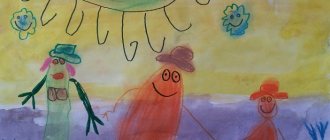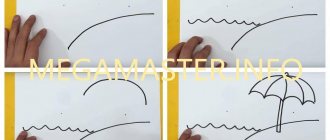Children's "scribbles" are nothing more than an effective way to develop a child's fine motor skills and artistic taste. When drawing, the child’s imagination grabs hold of the images and transforms them into dashes/dots/blots. In general, one cannot underestimate all the benefits of this simple but very exciting activity.
You can start drawing with your child from 8-9 months: first with finger paints, then adding other tools. By the age of 2-3, the child already clearly understands what this process is and understands the meaning of color and shape.
If your child sits at home or goes to a nursery, then you will have to act as an art teacher (as a rule, in a nursery with kids they draw “anyhow” - too “troublesome” activity).
What will you need for drawing?
How can a child draw?
Don't be afraid to experiment with different tools. Anything that leaves a mark can be used for your activities.
Standard means:
- Finger paint. Price - from 250 rubles. You can find many recipes online on how to make similar paints yourself.
- Wax pencils and crayons.
- Ordinary crayons. Draw on asphalt, slate, pebbles, etc.
- Lead pencils.
- Paints: watercolor, gouache.
- Markers and felt-tip pens.
Some mothers say that it is too early to give pencils and thin felt-tip pens to a child at the age of 2, since due to “light child pressure” the lead will break and the rods will be pressed in. But the argument in favor is the provision of choice, variety, assortment. Don't skimp on markers and pencils (and don't buy the cheapest ones, which are really bad for drawing).
In stores like “Fix Price” you can sometimes buy some unusual drawing supplies. Let this be a one-time activity, but variety (I repeat) is very important. For example, a kit for painting with glitter on velvet paper. Or markers that you need to blow into.
Choosing pencils and markers
So, short and triangular pencils will teach your baby to hold them correctly.
In addition, the first pencils for drawing should be very soft so that they can leave a mark on the paper without strong pressure. These can be wax and plastic pencils, water-based pencils. They are easily sharpened with ordinary sharpeners, leave soft and even strokes, and the designs are rich and bright. Such pencils do not stain your hands, are easily washed off clothes, and have no odor.
And of course, your baby can easily draw with felt-tip pens. Now on sale there are harmless markers with ink based on food coloring. They also sell felt-tip pens that can be easily washed off your hands and clothes.
What to draw on?
Most often, children are offered A4 sheets. This is a fairly budget option, taking into account the fact that a child can draw one line with a brush across the entire sheet and demand a clean one for a new “plot”. But it will be great if the drawing lesson is held on a large sheet of whatman paper laid out on the floor. “Large drawing” is very useful for a child. He is still just mastering the world around him and the “ways of influencing” it. It is quite possible that he will want to paint himself. Or walk with your decorated feet on the floor, while experiencing extraordinary delight.
Instead of expensive sheets of whatman paper, you can use a roll of cheap white paper wallpaper.
In addition to paper, you will have to stock up on: sippy cups (sometimes you can set out larger dishes with water), a palette for mixing paints. It will be very good if you have a double-sided board in your house (on one side you can draw with chalk, on the other with markers).
Some more advice for concerned parents
Do you know what a big step in development for a baby is the first line on paper with a pencil? This is like man's first step in space, no less! A particularly valuable stage is when the child begins to “read” his drawing, moving from chaotic strokes to the same strokes, but meaningful. Kids depict many things in the same way - now it’s grass, now it’s a tree, now it’s an uncle.
Children of pre-Sadovo age perceive a drawn image as a real object or being. The change in doodles is directly related to changes in the psyche, its maturation. It’s not for nothing that psychologists work on children’s drawings, since this is a window into the world of a child who cannot express his experiences in words.
An adult plays a major role in a child’s life, so at an early age the main way to teach drawing and other types of creativity is demonstration. This means that you show and help your child draw. Move it with your hand and strengthen your motor skills. I repeat that we comment on all movements using auditory and visual memory.
Remember that at an early stage in children’s lives, the goals are: to arouse a strong interest in creativity and to instill skills in working with tools and materials. It is important to initially teach how to use the tools correctly, for their intended purpose, but gradually, as they grow older, to introduce new and non-standard techniques and materials.
What and how to draw with a child aged 2-3 years?
A two-year-old child is able to repeat simple visual shapes: lines, dots, circles, triangles, polygons. If you are studying the alphabet, then also letters (a separate material will be devoted to this topic).
At this age, children already understand that they can depict the world around them on paper. Adults are often asked to draw something specific, and they begin to make attempts to do it themselves.
From the author: my daughter did not yet know how to speak, but she drew a wavy line and said “sh-sh-sh,” which means “snake.”
— A child can paint over the shapes drawn by an adult . Shading (shading) is a good way to quickly master a tool and develop hand-eye coordination. And even if the shading “goes” beyond the boundaries at first, over time the baby will get better and better.
To interest your child, you can come up with games and stories. Draw a mouse and a cat. “Oh, the cat is about to catch the mouse!” Let's help her hide!
— Drawing lines. Playing trail games is also very interesting. Draw animals on one edge of the sheet and the food they eat on the other. For example: mouse, squirrel, hare and cheese, nut, carrot. Offer to draw paths along which each animal can walk to its lunch.
— Drawing points. Rain, grains for a chicken, sand on the beach, seeds in a ripe watermelon - these and other scenes can be played out to teach a child to put dots. At the same time, pay attention to the pressure, tell your child what the result will be if you press the pencil harder/weaker.
— Stamping. In FixPrice stores or in stationery departments you can buy simple stamps with animal figures, leaves, and drops. Teach your child to use them, and then “draw” your story. In addition to prints, a story can “contain” sticker characters.
You can make your own stamps. Cut out a figure from a PVC packaging substrate (greens and packaged confectionery products are sold on such substrates in stores). Glue onto a piece of foam using a hot glue gun. The foam should be of such a shape and size that it is comfortable for the child to hold it. Soak a sponge in colored water or ink to color the stamp.
— Using an eraser. Show how to use an eraser. “Here is the path (draw with a simple pencil). Winter came, a strong wind blew, it covered the path with snow and it became invisible.” You can come up with other stories.
Another great erasing exercise: draw with chalk on a slate board, give your son/daughter a brush and a glass of water. The task is to erase the drawn lines with a wet brush. If this seems a little complicated for now, then wiping it with a regular rag will definitely do!
— Drawing from a stencil, tracing figures. The child himself will be able to draw from a stencil when he is closer to 3 years old and older. But at 2 it’s not too early to start introducing him to this method of depicting objects! Start tracing arms, legs... maybe the baby will lie down completely on whatman paper and you will trace him - it’s so exciting! Show how to trace stencils outside and inside (cut out the shapes yourself from thick cardboard; the edges can be covered with tape to last longer).
An alternative way to work with a stencil is to use a roller. Dip a roller (small size) into the paint and roll it over the surface of the paper inside the stencil. Let the baby repeat. It doesn’t matter if it goes abroad a lot, the drawing will still turn out good.
Most importantly, don't limit yourself to the lessons provided! Use your imagination, play with your baby, help him develop his sense of beauty and transfer what he has in mind to paper. Here are some more ways to draw.
Examples of custom drawing
The methods can be adapted for younger and older children.
Drawing on sand/semolina with a finger/stick.
All kids like this method. It develops fine motor skills and tactile sensitivity. If possible, build something like a light cube - a box with a transparent lid with a light bulb inside. Drawing on a thin layer of sand on such a box is very entertaining.
Coloring crafts made from salt dough.
After modeling, you may end up with various figures that your child will be happy to paint. If he still doesn’t understand well that mixing all the colors in a row will only result in “dirt,” give him one jar of paint at a time. Then, when the drawing on the figure dries, take out the next color.
Drawing with crayons on stones.
If you go to the sea or to a rocky beach in the summer, be sure to take a box of crayons with you. While you are sunbathing, your baby will have something to do - coloring rock candy.
Drawing with colored ice.
This activity is especially relevant for hot summer days. Freeze ice cubes by adding colorful paints to the water (regular watercolor will do). Place your child on a piece of Whatman paper and give him a container of colored ice. Having coped with the task of removing the cold cubes, he will move them around the paper until they melt.
Use of available materials.
Draw with everything you can get your hands on! (Well, or almost everyone...) Study the result, comment, discuss with your child. You can dip glass balls in paint and roll them inside the box: let the child tilt the box to the sides and follow the multi-colored trace. You can use a fork to draw a lion's mane, spruce paws, or hedgehog needles. And so on!
If your son is passionate about cars, dip the wheels in paint and let him “drive” his vehicle on a piece of whatman paper. And you help him draw a road, trees along the road, a traffic light and a pedestrian crossing.
Drawing as part of the game.
Combine drawing with other activities: appliqué, paper crafts, and natural materials. Maybe you have fabric paints at home? Buy a white T-shirt and let your child design it himself! You can print his palms on a T-shirt - not only will it be a drawing activity, but it will also be a memory for many years.
The child has grown up - it’s time to complicate the drawing technique
Above, I talked about children from 8 months to 1.5 years, who are just beginning to learn the secrets of fine art. Ideally, they can already hold a pencil and brush correctly and know what to do with these objects. Children of this age can draw a line and distinguish several colors.
We've been here for 2-3 years now. It is necessary to complicate the tasks: in order to positively motivate the child to draw, I advise you to actively use nursery rhymes, poems, and fairy tales on various topics. Inspire children, create a good mood so that they have an irresistible desire to convey their impressions through drawing.
Pictures in sets on topics: house, animals, people will be very useful to you. We told a poem, showed an illustration, then we drew together. Invite your child to continue your drawing to begin with. So you wanted to portray Pinocchio, for example. You start with the head, the torso, the baby finishes drawing the nose, arms and legs.
It is important to talk to children, comment on your actions, thereby developing the speech and vocabulary of the little artist. As you already understood from my previous articles, everything that you and we do with children is aimed at their comprehensive development.
Drawing is also communication between the participants in the process. By not just putting a pencil in your child’s hand, you are developing the child. You need to actively participate in learning, come up with new techniques, motivate children, feel the lack of interest and be able to maintain persistent interest. Change materials - paint not only with gouache, but also with toothpaste, in general in different ways and techniques.
I described in detail non-traditional and traditional methods in articles under the “Drawing” section. With skillful organization of home activities, you can literally make your child fall in love with fine art for life. As a result, you will grow a non-standard personality, capable of creative solutions and creation.
What to draw with children? Here, just winter, is a fertile topic. We make fingerprints with white paint - that's snow for you. They crawled on the paper - and the snowman melted... The main thing is the desire of the parents to give the child everything necessary for the comprehensive development as a spiritual person.
The most important rule of drawing with a baby!
Have enough patience and don't get irritated while painting with your two year old! Even if he, expressing a desire to draw, forced you to unscrew 8 caps from the gouache, and then a minute later switched to another activity. Just close the jars and put them away until next time, but under no circumstances reproach your child or force him to draw with force. Believe me, only in this case there will be real benefits from the classes!
Add your drawing methods in the comments. Let's help our kids grow up smart and with a developed artistic taste!
If you are interested in learning other ways to develop fine motor skills, you can read about playing with cereal here.
I want to show our drawings in the nursery. There are not many of them (since adaptation to kindergarten took place with “frequent snot”), but you can see what is offered to kids in kindergarten. For those interested, look at examples of drawing in a nursery.
How to organize a drawing lesson for children 3-4 years old?
- Think about the activity. Play out in your mind the entire sequence of what you and your child will do. Stock up on wet wipes and cloths so that you have them at hand if necessary.
- Give an example of what should happen as a result of the lesson. This can make it very easy to explain the material.
- Take a doll, animal or cartoon character and conduct an activity with its help. Children will be happy to support and help the puppet teacher.
- Think about what photographs, pictures, videos and audio materials you can use in class. This will make your lesson fun and interesting.


